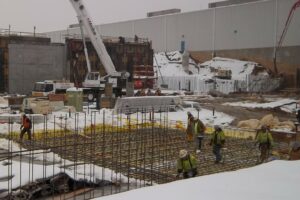 “Cold” Man Winter will soon be returning to the Northeast bringing seasonably cold, wet weather capped by a blizzard in February. At least, that’s what the Farmer’s Almanac says. If the prediction pans out, we’re facing a cold, icy winter. When the temps drop to 40 degrees Fahrenheit and lower, placing concrete can be challenging. Concrete sets slowly during cooler temperatures, and if freshly placed concrete freezes before reaching a minimum strength of 500 psi, it could lose up to half of its ultimate strength.
“Cold” Man Winter will soon be returning to the Northeast bringing seasonably cold, wet weather capped by a blizzard in February. At least, that’s what the Farmer’s Almanac says. If the prediction pans out, we’re facing a cold, icy winter. When the temps drop to 40 degrees Fahrenheit and lower, placing concrete can be challenging. Concrete sets slowly during cooler temperatures, and if freshly placed concrete freezes before reaching a minimum strength of 500 psi, it could lose up to half of its ultimate strength.
But not all winter construction is lost. Concrete can be placed as long as precautions are taken to keep it from freezing while still fresh. The goal is to keep concrete at a minimum temperature of 50 degrees Fahrenheit until it reaches 500 psi. At this point, it can handle the cold on its own.
The following are a few tips for cold-weather concreting:
- Talk to your ready-mix producer! Mix designs can be adjusted to include increased cement content, chemical admixtures that accelerate set time and air-entrainment admixtures that reduce bleeding, which helps with freeze-thaw. It’s also best to place concrete at the lowest practical slump.
- Heat one or more of the concrete materials (water and aggregates-NOT cement). Again, this is handled by the ready-mix producer.
- Use concrete pumps to speed the placement of concrete.
- Use plastic sheeting or insulating blankets during curing to prevent heat and moisture from escaping concrete. Triple-layer protection is needed at all corners and edges.
- In more severe weather, use windbreaks, enclosures (tents) or supplementary heat (i.e., heaters). Ground heaters may also be needed to thaw frozen ground before pouring.
- Spray concrete with solvent-based curing compounds or cure-and-seal chemicals to avoid freezing.
- Leave forms in place as long as possible to help distribute heat more evenly and prevent drying of the concrete.
- Remove heat slowly to prevent concrete from cooling too quickly and cracking. Try loosening forms while concrete is still covered, gradually decreasing the heat inside an enclosure, or turning off the heat and allowing the enclosure to slowly equilibrate to ambient temperature. Massive structures may require several days or even weeks of gradual cooling.
Let us know how we can use our experience to help you ensure a successful project during cold-weather conditions.